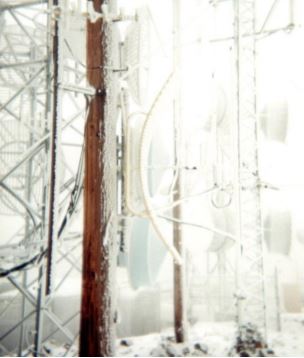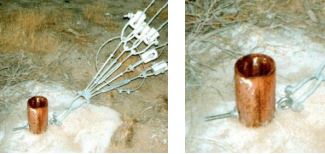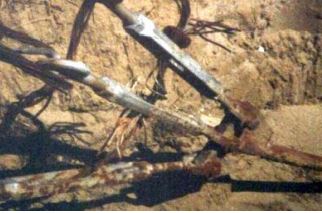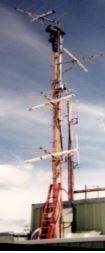Tower Climbing and How To Avoid Dangerous Tower Events

[February 2020] Some folks really like heights. Looking out from the top of a 1500 or 2000-foot tower can bring special satisfaction. For them, climbing a 200-foot stick was almost sort of like the rest of us getting up on a large step-ladder. However, regardless of height, good tower guys always play it very safe. David Rose explains:
Over the last 39 years I have worked on dozens of towers.
My love of climbing towers goes back to my childhood when I climbed tall trees. Sometimes we built tree-houses and used steps. It was great fun and I was lucky and never got hurt.

Today us big kids climb towers and get paid to do it and it is much safer and can be just as much fun. I call it paid fun with good views and nobody bothers you when you are up at the top.
Learning How
Actually, I have never had real formal training but I did pay attention and learned from some very good tower crews. Among the various things I learned were a number of important general pointers that I can pass on today to younger guys who are learning to climb towers. Things like:
- The full-body harness with lanyard is the best according to OSHA.
- Always use safety equipment – especially good boots. Standing for hours on rungs of towers with tennis shoes will convince you not to do that again.
- Things like wearing a helmet – especially if working on the ground below the tower – is a good idea.
- Wear warm clothing since it might well be nice at ground level but windy with a chill factor at the top.
- Try to always be connected to the tower.
- Always carry a two-way radio or a cellphone to get help.
- Some towers have a cable running up with a clutch mechanism to slide but will lock if you fall.
- When you are on a guyed tower and it does not sway at all – get off it! The tension on that tower is too tight and it is not safe.
- Always use a spotter on the ground.
- The gin-pole is always the best way even though it is slower.
- The use of cranes and helicopters have always bothered me since you are then depending on someone else for safety.
Putting It All to Work
With those tips in mind, I have developed a set of rules to I use, as a checklist, before climbing any tower. Like an airline pilot, I do a walkaround, checking these points:
- Check all anchors for rust, missing nuts and sabotage.
- Look at the guy wires, turnbuckles and insulators.
- Check the conduit for the lights and the feed lines.
- Look for rust on tower legs and connectors.
- Are the guy-wires too loose or with broken insulators?
If each of these items check out OK, then it may be safe to proceed.
Dangers to Watch For
Here is why you need to do those checks above before putting your first foot on the tower.
In doing a careful inspection, you may well observe some things that either might have caused the tower to be in dangerous condition or that could well cause such to occur. If you see something like the following descriptions, it is not the right time to climb!
1. Towers in severe icing areas easily can get overloaded and bend or fall. These towers need extra bracing and de-icing gear. When close-spaced like this, one can fall and kill several nearby towers.

2. Towers have fallen because of special anchors that were not engineered correctly, or from material failure.

3. Some towers cannot be climbed – they came down because of sabotage, vandalism or insurance fraud.
4. Towers that have severe corrosion on anchors can and will snap in high winds or icing situations.

5. Fire, tornados, hurricanes, floods, earthquakes and other acts of nature can damage or bring down a tower.
6. Low flying planes and helicopters like crop-dusters can snag a guy-wire or hit a tower. Yes, it does happen.

7. Unprotected guy-wires and anchors in fields where there are livestock or where vehicles can hit them.
8. Overloaded towers often can become very unstable and fall.

9. Many towers have fallen from accidents during construction or maintenance.
10. Telephone poles especially are to be avoided unless you happen to like creosote, lots of slivers, and pole-pegs with no place to tie-off.

Common Sense While Up There
As you climb and do whatever work you have planned, here are some more common sense pointers worth remembering:
- Never be in a hurry, stressed, or lacking sleep when working on a tower.
- Never climb while intoxicated.
- Make sure you are covered with liability and medical insurance from the tower owner, the company, or yourself.
- Follow OSHA and state rules, codes and regulations. It is for your safety.
- Always carry some water and snacks.
- The ladder used to get on the tower is the most dangerous first step!
- Check to see what is at the base of the tower before stepping off. Look for rattlesnakes!
- Do not try to carry heavy equipment up tower. Use a pulley and rope hoist.
- Do not attempt to use one hand to carry equipment up tower. Use a backpack, tower bucket or belly-pack.
- Never leave loose bolts, straps or ground wires on towers.
- Always have stations drop power when you will be passing their antennas.
- Avoid stepping on coax, heliax, rigid line, and conduit.
- Stay off towers during icy conditions.
- Parking too close to towers could be hazardous to your truck and you.
- Avoid working on antenna’s mounted in trees. Call a logger.
- Never change out lamps with power applied. You are hanging onto a very good ground!
- Never drop anything off a tower on purpose. Use a basket.
- If you have to use power tools always use the battery type.
- Know when it is necessary to back off and call a professional tower rigger.
Time to Get Down
When I climb, there are situations that immediately alert me to get off the tower as quickly as is safely possible. You should be alert for the same issues, too:
For example:
- As mentioned above, if the guyed tower has no sway, something is wrong.
- If you find lamps removed. It makes you think: “What else did they take?”
- If you notice hunters shooting or even just carrying guns. You may become a target!
- If there are crop-dusters in the area, especially ones flying under the guy-wires.
- If you get dizzy, ill, or fatigued. Passing out on a tower is not a good idea!
- If someone is running heavy equipment near the tower or anchors. Farmer Frank may be plowing – and he might hit a guy wire or tower leg.
- If there are high winds and poor weather remember: you are adding more wind-loading for the tower!
- If you see or hear dark clouds, lightning, or thunder, there is a danger of becoming a human lightning rod!
- If you find any structural damage such as missing bolts, etc.
- If safety equipment not working.
- If power to the antennas is not off as directed, your goose may well be cooked!
Stay Away!
Some of the worst towers I have seen have been Ham towers.
All too often I end up seeing things like anchors not set in cement or connected to structures. I have seen towers connected to houses with scary brackets. And to make matters worse, many Hams have no safety equipment and still climb their towers unprotected.
By no means am I saying all Ham towers are in bad shape or are dangerous but, in general, I am much more careful in evaluating such towers and decline to get very close to any that look improperly built.
In Summary
By using common sense, the right tools and harnesses, and taking careful steps, you can learn to safely climb towers to maintain them – and to see all sorts of great sights from above transmitter buildings.
– – –
David Rose, CPBE, KB7A is the proprietor of StaticDevil.com. You can reach him at: davidrose88@aol.com
